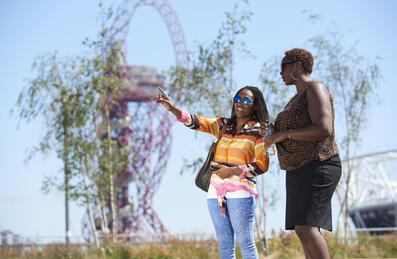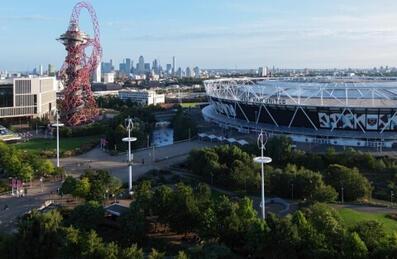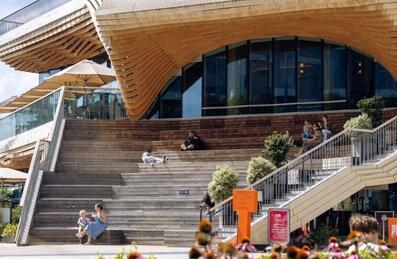
Popular Searches:
Keep up to date
Sign up today for exclusive offers and incredible experiences you won’t want to miss at Queen Elizabeth Olympic Park.
Sign up nowRare species found in latest monitoring on Queen Elizabeth Olympic Park
Rare species found in latest monitoring on Queen Elizabeth Olympic Park
Press Release 16/09/2020
- Six ‘schedule one’ birds recorded on Park- among the rarest in the UK
- 28 species of wetland plants
- 150 bat boxes
- 525 bird boxes
- Park haven for local people during lockdown
A new environmental report for Queen Elizabeth Olympic Park published today reveals that the Park is flourishing and home to a range of rare plants and animals including the streaked bombardier beetle, black redstart, sand martin and brown-banded carder bee.
The Biodiversity Action Plan (BAP), is published roughly every five years and sets out the long-term environmental management of the Park to maintain and enhance its biodiversity.
The creation of the Olympic Park in 2008 and its transformation into Queen Elizabeth Olympic Park in 2012 provided unique opportunities to regenerate part of east London and put in place new ideas about the role and design of urban parks. Nature and green space were seen as huge assets and the Park’s first BAP in 2008, (the first produced for an Olympic Park), outlined proposals to create 10 new habitat types including wildflower meadows, woodlands, and wetlands. The BAP also aimed to weave together the needs of wildlife with those of local people.
Twelve years later and the latest report finds that the Park is a haven for rare species, both flora and fauna. Six ‘schedule one’ birds have been recorded on the Park; schedule one birds are among the most protected in the UK (the following schedule one birds found on the Park are: kingfisher, black redstart, Cetti's warbler, fieldfare, redwing and peregrine falcon). In addition, over 1100 invertebrate species have been recorded, including 91 with a significant conservation status (e.g. nationally scarce).
Other notable species include:
- The streaked bombardier beetle, is so rare it was thought to be extinct, until a small number were discovered in east London about 15 years ago. These beetles are found on brownfield habitats across the Park. The beetle defends itself by spraying a boiling mixture of chemicals at its predators.
- The black poplar tree grows alongside rivers and waterways. This is the tree that gave the east end district of Poplar its name, because there were so many along the marshlands. It is now the UK’s rarest native tree. The Park has 100 black poplars, most of which grow in the wetlands and along the banks of the River Lea.
- The black redstart is one of Britain’s rarest birds. Numbers of the birds in London grew during the 1940s as sites left derelict by the blitz offered them the ideal breeding habitat- hence the nickname ‘the bombsite bird.’ They are a rare sight, but you might spot one along the Lea navigation.
- The sand martin, a small bird, only spends part of the year in the Park. They are summer visitors and arrive in April or May, and then leave by mid August, to start their long journey back to Africa, where they spend their winter months. Look out for them along Carpenter’s Lock.
- The brown-banded carder bee is a ginger coloured bee that nests on the ground in long grass. The bee depends on a variety of flowers like clover and knapweeds that are found in wildflower meadows. The species has declined rapidly with the loss of these meadows, and it can be seen from May onwards in meadows and grasslands across the Park.
- Eels were once abandoned in the Thames, but numbers of European eels have dropped dramatically since the 1980s, making eels one of our most critically endangered species. European eels have been found in all four of the Park’s waterways, but never in significant numbers, which highlights just how threatened this species is.
- Reed buntings are one of the Park’s conservation success stories as there are few records of these rare birds on the site before the Park was built, but since the wetlands and reed beds were created, there’s been a steady increase in their numbers, and reed buntings have been recorded here breeding every year since 2013. During the spring and the summer you can see adults and their young in and around the reed beds of the north Park.
- The wildflower meadows are an important habitat that supports lots of wildlife. This habitat is considered rare, as 97% of all the UK’s meadows have been lost since the 1930s. One of the wildflowers that the meadows support is the common knapweed- a bright purple flower that blooms between June and September. The flower is particularly popular with goldfinches, which feed on its seeds, and the birds can often be seen in large flocks, called charms, around the Fantiscology meadows.
- The Park is home to seven different bat species. Bats are nocturnal. The Park has 150 bat boxes, many of which you can see underneath the bridges. Our smallest bat is the common pipistrelle, which has been recorded on the Park numerous times, foraging along the river corridors.
- The cetti's warbler was unknown in the UK until the 1960s. These birds are very elusive and like to stay well hidden in vegetation, and are said to have one of the loudest songs of British songbirds, meaning that you have more of a chance of hearing one than seeing one. Listen out for the warbler by the north Park reed beds.
The Park and its wildlife proved to be a lifeline for many east Londoners during lockdown, with the parkland and its flora and fauna providing safe, open space for exercise and relaxation.
Park Champions, the volunteers who help run the Park, play a key role in delivering the BAP tasks. In total, Park Champions have scythed over 13,000m2 of grasslands, and managed invasive species along 2km of river corridors. They have recorded 20 different species of butterfly recorded during their survey work.
The 10 habitat types selected to create the new Park reflected the diversity of the site prior to construction, as well as the desire to restore different types of vegetation to the area. The restoration of the waterways was a major part of the project, and involved the re-profiling of banks and channels that had seen centuries of intensive use. Over 300,000 wetland plants (comprising 28 species) were grown and planted to create the wetland habitats. A variety of habitat installations were built into the fabric of the Park; the installations included 150 bat boxes, 525 bird boxes, and two otter holts. Over 48 hectares of new ‘BAP habitat’ have been created on the Park to date.
Ruth Holmes, Design Principal, London Legacy Development Corporation, said: “We are thrilled that landscape that has been created as part of the regeneration supports so many rare species that have find suitable habitats at Queen Elizabeth Olympic Park. The BAP helps to protect these vital plants, bugs and birds, which has such a positive impact on the communities using the Park especially as construction on exciting new developments like East Bank gets underway.”
Catherine Norris, Biodiversity Manager, id Verde said: “It has been great to see the development of the Park and the ambitions of the BAP come to reality. I’ve seen first-hand the benefits that the Green Infrastructure has had for our visitors and volunteers, and the value of parks for people and wildlife. The teams of Park Champions have played an important role in helping us manage and monitor BAP habitats and species. I hope that this version of the BAP will encourage more people to engage with nature and its conservation.”
James Hitchmough, Professor of Horticultural Ecology, University of Sheffield, said: “The new Biodiversity Action Plan for Queen Elizabeth Olympic Park provides the opportunity to seamlessly integrate both biodiversity support and human wellbeing in the management of a major designed urban landscape.”






